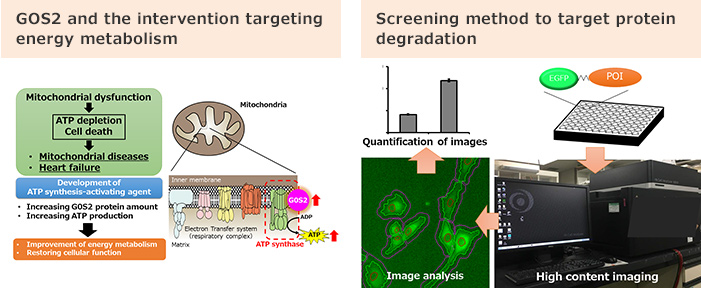Researcher: Hisakazu Kato


TOP PAGE > Drug discovery targeting protein degradation pathways
he heart is required to respond promptly to the constantly changing demand of blood supply and consumes the most energy (ATP) of all organs in the human body. Recently, we have identified two proteins “Higd1a” and “G0s2” as regulatory proteins of energy production [1, 2]. Higd1a and G0s2 enhance energy production by binding to Complex IV (cytochrome c oxidase) and Complex V (ATP synthase), respectively.
In the analysis of G0s2 function, we developed an important technique to visualize mitochondrial ATP dynamics of heart in vitro and in vivo. This allowed us to measure intracellular ATP, which we could assess using cell lysates so far, in living cells. This method is a very important technique in order to verify molecular mechanism of heart, which consumes vast amount of energy.
We proposed that G0s2 becomes a therapeutic target of diseases impairing mitochondrial energy production such as mitochondrial diseases or ischemic heart failure. Thus, we have developed the screening method targeting protein degradation pathways, in addition to verifying the mechanism by which G0s2 protein is degraded. In our method, we can simultaneously observe the changes in both “protein amount” and “cell morphology” using high-content imaging system of analyzing cell images in a high-throughput manner.
This screening method also would allow us to perform various compound screening to develop novel therapeutic drugs. We recently progress novel anti-cancer drugs targeting protein degradation, in collaboration with the Department of Gastroenterological Surgery.

[1] Hayashi T, et al., Proc Natl Acad Sci U S A. 2015; 112(5):1553-8.
[2] Kioka H*, Kato H*, et al., Proc Natl Acad Sci U S A. 2014;111(1):273-8.
Researcher: Hisakazu Kato